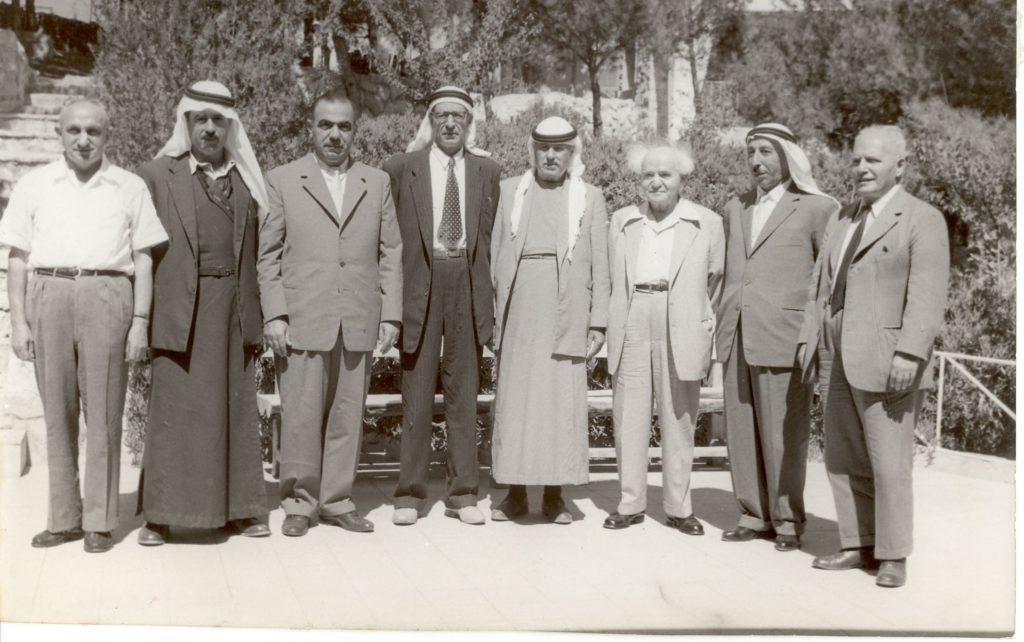Ed. Note: Ofra Bloch’s article, “Hierarchical Inclusion: The Untold History of Israel’s Affirmative Action for Arab Citizens (1948-68),” appears in the February issue of Law and History Review (vol. 39, no. 1, February, 2021, pp. 29-68.). We spoke with Professor Bloch about the making of the article and other topics, and are pleased to bring you the interview below.
The Docket [TD]: Thank you for taking the time to talk with us about your project! The title of your recent article in Law and History Review has a word and a phrase that will stand out to readers. Let me start with the word: “untold.” The story that you lay out here is incredibly complex as it unfolds in two stages through much of the 1950s and 1960s. But as you suggest it has eluded the view of historians. Why do you think that is?
Ofra Bloch [OB]: My article, “Hierarchical Inclusion,” portrays the history of employment affirmative action for Palestinian-Arab citizens of Israel during the state’s founding decades (1948-1968). Drawing on heretofore overlooked archival sources, my research showed that during the state’s first and even more so second decades, Israeli officials adopted minimum quotas for employing unskilled Arab workers in manual labor jobs, quotas for hiring educated Arabs in the civil service, and requirements and incentives for hiring Arabs in government offices, Jewish organizations, and businesses, as well as earmarked jobs and established vocational training courses for the Arab population. This article is the first to focus on this topic and provide a detailed description and analysis of these measures. The story I tell in this article is thus untold in a rather simple, empirical sense. While, historians and legal historians have thoroughly studied and debated the state’s approach toward the Arab minority in its first decades, they have largely overlooked the measures described in this article and their significance. The dominant narrative in the literature on Israel’s relationship with its Arab minority during those years, is one of “control”, marked by policies that secured Arabs’ subordinated position. Thus, focused on efforts to maintain the stability of the regime and on recognizable tools of oppression, scholars have largely missed, or in some cases dismissed, the state’s deployment of measures for promoting employment inclusion of the Arab population. My legal training, especially in constitutional law, has made me, I think, more sensitive to the use of those measures that look so much like what we today call affirmative action.

TD: And now the phrase: “affirmative action.” Obviously, in the United States that term evokes a broader debate about the state’s reparative approach to citizenship, labor, and rights. Can you explain a bit for readers as to why you see “affirmative action” as a useful framework for making sense of the Israeli state’s inclusion of the Arab workforce into its political economic plans?
OB: “Affirmative action” is, indeed, a loaded term. In contemporary political and scholarly debates over affirmative action, it is often associated with egalitarian commitments to redistribution and remedying past wrongs. Yet, these conceptions of affirmative action as an inherently egalitarian tool, are based on a form and a meaning that affirmative action assumed in a specific dominant historical context of the 1970s and 1980s in the United States. Other scholars, focused on other periods, have already shown that affirmative action was not always motivated by egalitarian rationales. Thus, in contrast to common understandings, for the purpose of this article, I define affirmative action not by its motivating rationale, but rather by the use of a specific set of techniques deployed today in Israel and other countries, which are commonly recognized as affirmative action: hiring quotas, marked tenders, and other forms of preferential treatment meant to promote the inclusion of disadvantaged groups into the workforce or higher education. This definition is intuitive and controversial at the same time, and, as such, I suggest that it creates a space to re-examine common assumptions about this tool and its contingent relationship to equality. It provides a framework for examining how affirmative action operates outside of its familiar historical context of struggles for equal citizenship. It highlights the dual nature of affirmative action as both an egalitarian tool and an administrative tool used to effectively manage subordinated minorities and advance social and economic control.
TD: The research for your article is intriguing. While you draw on a great many materials, your reading of the Israeli government’s directives and memoranda about Arab workers in the late 1950s and 1960s forms the core of your analysis. Can you walk our readers through what it was like to work with these official records? Were there any noteworthy challenges that you faced?
OB: The majority of the materials I used for this article are from the Israel State Archives. Over the years, issues of censorship and confidentiality made research of Israel’s official records difficult, or in some cases, impossible. While these issues are far from being resolved, working on this article, I was rather lucky. I started the research for the article in 2016, just a few months after the Archives were digitized. At that point in time, less than 2% of Israel’s official files were uploaded. Nonetheless, I was able to search, apply for, and (usually) not too long after, receive scans of files I was interested in. While this process is far from perfect (the opening of each file to the public requires an official approval), I eventually got the hundreds of files I was looking for. Situated in New-Haven, I received the files by e-mail, some with password protection. I visited the Archives in Jerusalem only once, but even there, to my surprise, I did not get to hold a real file. Instead, I was given a portable drive with 70 files that for some bureaucratic reason, the archivists were not allowed to send online.
Working with these archival sources was fascinating from the get-go, but it took me a great deal of time to understand their meaning, or actually, meanings. Working with materials from fifty to seventy years ago, and being well aware of the sustained subordination of the Arab minority long thereafter, my initial reaction to these affirmative action measures was to think of them simply as additional tools in the service of that oppressive regime. Although some elements of this interpretation ring true, I realized it wasn’t precise enough. It was at this point that I decided to separate my analysis to three parts: mechanisms, motivations, and effects. This method allowed me to avoid collapsing all three, and revealed a more nuanced picture of the past. I was able to see that measures known today as affirmative action were not only motivated by egalitarian reasons, but also (and mostly) by instrumental concerns about the security of the state and the economy, as well as concerns about international legitimation and a desire to garner Arab votes. It helped me understand that these mechanisms did not simply threaten or sustain the status quo. Instead, they were part of a wider transformation, from complete workforce segregation and strict military rule in the first decade of statehood, to a more integrated economic subordination during the following decade. This later form is what I refer to in the article as “hierarchical Inclusion,” a state of gradual integration of the majority of the group into the lower tiers of the economy, with only a minority integrated into higher tiers.
Let me give you a more concrete example. In 1960, David Ben-Gurion, Israel’s first prime minister, explained that the “Arab problem” is of two inherently contradictory aspects: the first “is the character [the state] needs to present to the world—a principle of equal rights and democracy. The second aspect is the security of the state. . . .” This contradiction, he explained, “can be minimized by taking the right policy.” Ben-Gurion went on to list a series of measures for integrating Arabs to the government and workforce. This short remark, in which Ben-Gurion advocates affirmative action measures mostly for instrumental reasons of promoting the state’s security and international legitimation, demonstrates what became clear to me only after going through hundreds of those sources. The picture that emerges from this story can not identified by a singular approach of the state towards the Arab minority. It reflects a changing, multivocal, porous, and often contradictory state. Once I stopped trying to categorize measures as either “good” or “bad”, I was able to catch a more realistic glance of the multiplicity of the state and its actors.

TD: What are you working on these days?
OB: I am currently working on a few projects, including one that I find particularly interesting and relevant, as it was born with and from the research for this article. On December 30, 2015, the Israeli government adopted Resolution No. 922, “Economic Development Plan for the Arab Society (2016-2020)”—A five-year plan to invest 15 billion Shekels to promote the economic rehabilitation and integration of Palestinian-Arab citizens of Israel. This plan has often been referred to as exceptional and unprecedented, due to its magnitude but also due to the fact that it was adopted by a right-wing government that has legislated and incited against the Arab minority. However, drawing on archival research (that I first encountered while working on Hierarchical Inclusion), my new project shows that Resolution 922 was actually preceded by similar programs, often adopted in times of oppression. Though understudied and undertheorized, periodical large-scale group-based economic development plans for the Arab population have deep roots in Israel’s early history, starting in 1958. This project aims to start filling this gap by developing a better understanding of group-based economic development and integration plans in Israel and beyond. It seeks to explore the nature and origins of this legal tool, and to examine the conditions under which such plans were previously adopted and the obstacles for their successful implementation. Studying these policies over time and across polities could enhance our understanding of how they operate today in Israel and elsewhere.
TD: You finished up your graduate work at Yale Law School a few years ago and now teach in Tel-Aviv. These are two cities with strong if often overlooked food cultures. Give us a few of your favorite restaurants that you’ve been able to visit in these cities over the years.
OB: The best thing about New-Haven is that it is close to NYC (only 1 hour and 40 minutes on the Metro North). This allowed me to live, and more importantly eat in New-York. So, even though I liked eating at Bar pizza and Maya’s Sushi in downtown New-Haven, I was able to explore NYC culinary scene. As a Vegetarian (and an aspirational vegan) some of my favorites were NIX, Hangwai, Avant Garden, Blossom, Han Dynasty and Atlas, as well as eating the Impossible burger available now in so many restaurants in the city. Since returning to Tel-Aviv, all we can do is take-away due to the pandemic, but I can still mention some of my all-time favorites, such as Thai house, Anastasia and OPA.


 She is also a graduate of the Adi Lautman Interdisciplinary Program for Outstanding Students at Tel-Aviv University. Bloch is the recipient of the Alon Fellowship for outstanding junior faculty, as well as the American Society for Legal History Kathryn T. Preyer award. Prior to her graduate studies, Bloch served as a Law Clerk to the Honorable Justice Esther Hayut of the Supreme Court of Israel. Readers can follow her work on her
She is also a graduate of the Adi Lautman Interdisciplinary Program for Outstanding Students at Tel-Aviv University. Bloch is the recipient of the Alon Fellowship for outstanding junior faculty, as well as the American Society for Legal History Kathryn T. Preyer award. Prior to her graduate studies, Bloch served as a Law Clerk to the Honorable Justice Esther Hayut of the Supreme Court of Israel. Readers can follow her work on her